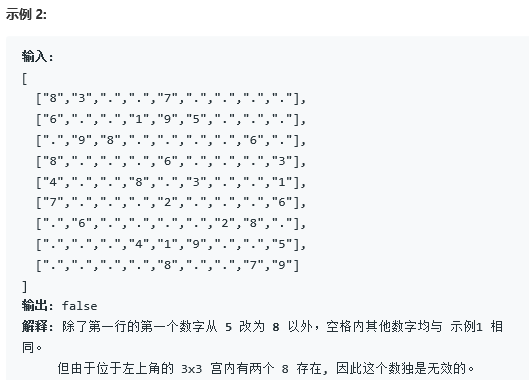leetcode-36-有效的数独
问题:




package com.example.demo; import java.util.HashMap; import java.util.Map; public class Test36 { /** * 思路: * 构建多个map,二维数组中,每一行是一个map,每一行是一个map,在一个3*3的方格是一个map * 在遍历二维数组的时候,将当前索引代表的值放入到不同的map中, * 同时在每次添加进map后,判断当前map中是否已经有重复的字符了 * Map<Integer,Integer>:key表示是哪个数,value代表出现过几次 */ public boolean isValidSudoku(char[][] board) { Map<Integer, Integer>[] row = new HashMap[9]; Map<Integer, Integer>[] column = new HashMap[9]; Map<Integer, Integer>[] box = new HashMap[9]; // 初始化数组 for (int i = 0; i < 9; i++) { row[i] = new HashMap<>(); column[i] = new HashMap<>(); box[i] = new HashMap<>(); } // 遍历数组,将每一行中的字符代表的数字放入map中,并将出现的次数自增 for (int i = 0; i < 9; i++) { for (int j = 0; j < 9; j++) { char num = board[i][j]; if (num != '.') { int n = (int) num; // 行内,将当前字符(数字)作为key放入map中,如果原来有则加1,没有则当前置为1 row[i].put(n, row[i].getOrDefault(n, 0) + 1); column[j].put(n, column[j].getOrDefault(n, 0) + 1); // 当前i,j属于第几个3*3的方格 int boxIndex = (i / 3) * 3 + j / 3; box[boxIndex].put(n, box[boxIndex].getOrDefault(n, 0) + 1); //判断每个map中的value是否大于1,如果大于则代表出现过多次 if (row[i].get(n) > 1 || column[j].get(n) > 1 || box[boxIndex].get(n) > 1) { return false; } } } } return true; } public static void main(String[] args) { Test36 t = new Test36(); char[][] arr = { {'8', '3', '.', '.', '7', '.', '.', '.', '.'}, {'6', '.', '.', '1', '9', '5', '.', '.', '.'}, {'.', '9', '8', '.', '.', '.', '.', '6', '.'}, {'8', '.', '.', '.', '6', '.', '.', '.', '3'}, {'4', '.', '.', '8', '.', '3', '.', '.', '1'}, {'7', '.', '.', '.', '2', '.', '.', '.', '6'}, {'.', '6', '.', '.', '.', '.', '2', '8', '.'}, {'.', '.', '.', '4', '1', '9', '.', '.', '5'}, {'.', '.', '.', '.', '8', '.', '.', '7', '9'} }; boolean validSudoku = t.isValidSudoku(arr); System.out.println(validSudoku); } }

